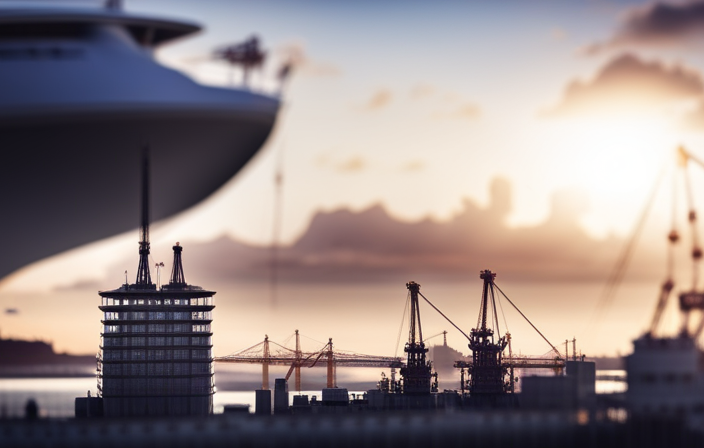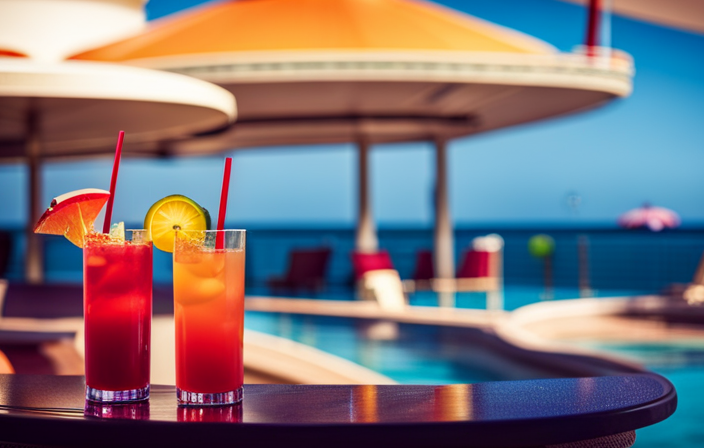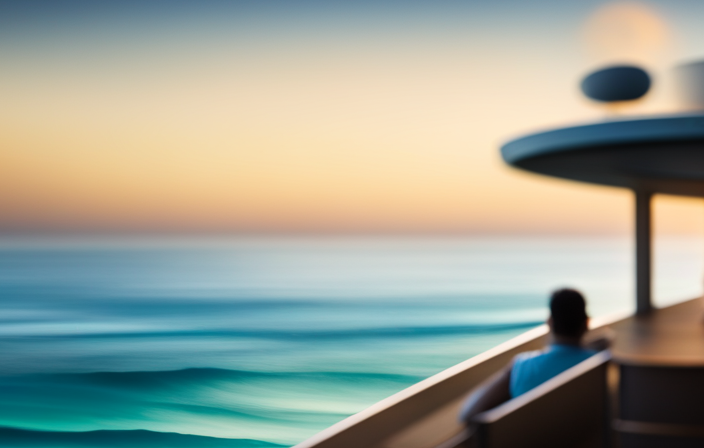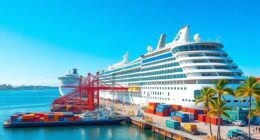Building a cruise ship is a massive project. It requires intricate planning, cutting-edge technology, and a vast workforce. The significant scope of the endeavor is equalled by the result: a splendid maritime retreat that offers unforgettable moments to its visitors.
So, how much does it actually cost to bring these magnificent vessels to life? In this article, I will delve into the intricacies of cruise ship construction and explore the financial considerations that come into play. From design and engineering to materials and labor, every aspect contributes to the final price tag.
We will also examine the challenges and risks involved, as well as the future trends shaping the industry. So, fasten your seatbelts, because we are about to embark on a journey into the world of cruise ship construction, where precision and innovation meet to create maritime marvels.
Key Takeaways
- Funding for cruise ship construction involves evaluating viable funding sources and making investment decisions based on return on investment and long-term profitability.
- Cost estimation and analysis for cruise ship construction involves considering factors such as size, amenities, construction materials, labor costs, raw materials, equipment, technology, regulatory compliance, and safety measures.
- Cruise ship construction takes around two to three years and involves various stages such as steel cutting, hull construction, outfitting, and testing.
- Challenges and risks in cruise ship construction include design and engineering complexity, coordinating multiple suppliers and contractors, and financial risks related to material and labor costs.
Overview of Cruise Ship Construction
Building a cruise ship can be a monumental undertaking, but it’s worth every penny for the luxurious and unforgettable experience it promises to offer.
Cruise ship construction techniques have evolved over the years, incorporating advanced technologies and materials to ensure durability and safety at sea.
From the initial design concept to the final product, every aspect of the ship’s construction is carefully planned and executed.
Sustainability is also a key consideration in cruise ship construction, with a focus on reducing environmental impact through energy-efficient systems, waste management, and the use of eco-friendly materials.
The design and engineering phase is critical in translating the ship’s vision into reality, balancing aesthetics, functionality, and safety.
This seamless transition from construction techniques to design and engineering is what sets the foundation for an extraordinary cruising experience.
Design and Engineering
Designing and engineering a cruise ship can be a fascinating and complex process. It involves tackling numerous design challenges and harnessing the latest engineering advancements. This intricate task requires a delicate balance between aesthetics, functionality, and safety.
To evoke emotion in the audience, I want to highlight some key aspects of this process:
- Formulating innovative and eye-catching exterior designs that create a sense of wonder and excitement.
- Crafting spacious and luxurious interiors that provide comfort and relaxation to passengers.
- Incorporating cutting-edge technology to enhance onboard amenities and entertainment options.
- Ensuring structural integrity and stability through rigorous testing and simulations.
- Implementing environmentally-friendly solutions to minimize the ship’s ecological footprint.
These design and engineering endeavors set the stage for the subsequent section about ‘materials and components,’ where we delve into the construction of a cruise ship.
Materials and Components
Crafting a cruise ship involves carefully selecting and integrating a wide array of high-quality materials and components to ensure the vessel’s functionality and aesthetic appeal. Building materials play a crucial role in the construction process. Steel is the primary material used for the hull and superstructure due to its strength, durability, and ability to withstand harsh marine environments. Other materials, such as aluminum and composite materials, are also utilized for specific areas to reduce weight and enhance fuel efficiency. The cost of these materials can vary depending on factors such as quantity, quality, and market prices.
Additionally, components such as propulsion systems, electrical systems, and interior furnishings contribute to the overall construction costs. The selection and integration of these materials and components require skilled workers and expertise in shipbuilding techniques.
Labor and Workforce
Ironically, without a skilled and efficient labor force, a cruise ship would merely be a collection of materials and components floating aimlessly on the water. The labor and workforce aspect of building a cruise ship is crucial in ensuring its successful completion. However, labor efficiency is often hindered by the shortage of skilled workers in the industry. This scarcity can lead to delays and increased costs during the construction process.
To mitigate these challenges, shipyards often implement strategies such as cross-training workers and utilizing advanced technology to streamline operations. Additionally, fostering partnerships with technical schools and investing in apprenticeship programs can help address the shortage of skilled workers. By optimizing labor efficiency and overcoming the skilled workers shortage, shipyards can enhance productivity and reduce construction costs.
Transitioning into the subsequent section about technological advancements, it is evident that innovation plays a significant role in further improving the cruise ship building process.
Technological Advancements
Embrace the exciting realm of technological advancements that’ve revolutionized the cruise ship industry. The integration of sustainable solutions and energy efficiency has become a top priority in shipbuilding. Advanced technologies such as solar panels, LED lighting, and waste management systems have significantly reduced the environmental impact of cruise ships. These sustainable solutions not only minimize carbon emissions but also conserve energy and resources.
For instance, the use of advanced propulsion systems, such as LNG or hybrid engines, has greatly improved fuel efficiency, resulting in reduced operational costs and emissions. Furthermore, the implementation of smart technologies, such as automated systems for navigation and maintenance, has increased safety and streamlined operations. These innovative advancements have not only enhanced the passenger experience but also reduced the ecological footprint of cruise ships.
Transitioning into the subsequent section about regulatory compliance and certification, we can explore how these technological advancements align with industry standards and regulations.
Regulatory Compliance and Certification
Transitioning into the next section, it’s fascinating to explore how cruise ships navigate the complex realm of regulatory compliance and certification, ensuring the highest standards of safety and environmental responsibility are met. Regulatory compliance involves adhering to a set of rules and regulations imposed by various governing bodies, such as the International Maritime Organization (IMO) and the United States Coast Guard (USCG). These regulations cover a wide range of areas, including safety, pollution prevention, and crew training. Certification, on the other hand, involves obtaining official recognition that a cruise ship meets specific standards and requirements. This typically includes assessments of the ship’s construction, equipment, systems, and operational procedures. The table below provides a summary of key regulatory compliance and certification requirements for cruise ships:
| Category | Regulatory Compliance | Certification |
|---|---|---|
| Safety | Compliance with SOLAS | International Safety Management Code |
| Pollution control | Compliance with MARPOL | International Air Pollution |
| Prevention Certificate | ||
| Crew training | Compliance with STCW | International Maritime Organization |
| training certificates |
Transitioning into the subsequent section about ‘financial considerations’, it is important to understand the significant costs associated with meeting regulatory compliance and certification.
Financial Considerations
When it comes to building a cruise ship, there are several financial considerations that need to be taken into account.
Firstly, cost projections and budgeting play a crucial role in ensuring that the project stays within its planned financial limits.
Secondly, financing options need to be carefully evaluated to determine the most viable sources of funding.
Lastly, investment decisions must be made strategically, considering factors such as return on investment and long-term profitability.
Cost Projections and Budgeting
To get an idea of the financial commitment involved, you might be wondering how much it’ll cost you to build your very own cruise ship. Cost estimation and cost analysis are crucial in determining the budget for such a massive undertaking.
The cost projections for building a cruise ship can vary significantly depending on various factors, including size, amenities, and construction materials. A comprehensive cost estimation involves analyzing expenses related to engineering, design, construction, outfitting, and testing. It is essential to consider labor costs, raw materials, equipment, and technology required for building a cruise ship. Additionally, regulatory compliance and safety measures also contribute to the overall cost.
By conducting a thorough cost analysis, you can develop a realistic budget and ensure that you are financially prepared for this significant investment. Transitioning into the subsequent section about ‘financing and investment,’ it is crucial to explore options for funding your cruise ship project.
Financing and Investment
Securing the necessary funds and attracting potential investors are key aspects to consider when financing your cruise ship project. To finance the construction of a cruise ship, there are several options available.
-
Bank Loans: Many shipbuilders rely on loans from banks to finance their projects. These loans typically have lower interest rates compared to other financing options.
-
Private Equity: If you’re looking for a long-term investment, attracting private equity investors can provide the necessary funds. These investors often expect a share of the profits in return.
-
Bond Issuance: Issuing bonds in the financial markets can be a viable option for raising capital. However, this method requires a solid credit rating and a well-established reputation.
-
Government Assistance: Some governments offer financial assistance or tax incentives to encourage shipbuilding projects within their jurisdiction.
Maintaining strong investor relations is crucial throughout the financing process to ensure continued support and secure additional funding. By successfully securing the necessary funds, the next step is to move forward with the construction timeline and process.
Construction Timeline and Process
The construction of a cruise ship involves a complex timeline and process. It typically takes around two to three years to build a cruise ship, from the initial design phase to the final delivery.
The construction timeline can vary depending on the size and complexity of the ship, as well as the shipyard’s capacity and resources. The construction process includes several stages, such as steel cutting, hull construction, outfitting, and testing. Each stage requires meticulous planning, coordination, and skilled craftsmanship.
Throughout the process, the shipyard works closely with the cruise line to ensure that the ship meets all the necessary safety and quality standards. However, building a cruise ship isn’t without its challenges and risks, which will be discussed in the subsequent section.
Challenges and Risks
Navigating through the construction process of a cruise ship can be like navigating through a tumultuous sea, with challenges and risks lurking at every corner. The challenges and risks involved in cruise ship construction can have significant financial implications.
One major challenge is the complexity of the design and engineering required to create a safe and functional vessel that meets industry standards. This can lead to unexpected delays and increased costs.
Additionally, the construction of a cruise ship involves coordinating multiple suppliers and contractors, which can result in logistical challenges and potential quality control issues.
Financial risks include fluctuations in the cost of materials and labor, as well as the potential for cost overruns due to unforeseen problems or changes in regulations.
However, despite these challenges, the cruise ship industry continues to thrive, with advancements in technology and innovation driving future trends in cruise ship construction.
Future Trends in Cruise Ship Construction
Amidst the challenges and risks, the future of cruise ship construction sets sail towards a horizon of technological advancements and innovative design, where ships become floating cities of luxury and leisure. The industry is embracing sustainability initiatives to reduce its environmental impact. From implementing energy-efficient propulsion systems to utilizing advanced waste management technologies, cruise ships are becoming more environmentally friendly. In addition to sustainability, passenger experience improvements are at the forefront of future trends. Cruise lines are investing in state-of-the-art entertainment facilities, luxurious accommodations, and personalized services to enhance the onboard experience. The table below highlights some of the key advancements in cruise ship construction:
| Advancements in Cruise Ship Construction |
|---|
| Energy-efficient propulsion systems |
| Advanced waste management technologies |
| State-of-the-art entertainment facilities |
| Luxurious accommodations |
| Personalized services |
As the demand for cruise travel continues to grow, the industry is committed to pushing the boundaries of innovation and creating unforgettable experiences for passengers.
Frequently Asked Questions
What are the environmental impacts of cruise ship construction and how are they mitigated?
Environmental impacts of cruise ship construction are mitigated through strict adherence to environmental regulations and implementation of sustainable practices. These include reducing emissions, improving waste management, and utilizing eco-friendly materials, ensuring a more environmentally friendly approach to shipbuilding.
How do cruise ship companies choose the destinations for their new ships?
Cruise ship companies carefully select destinations for their new ships based on market demand, profitability, accessibility, and attractiveness. Extensive research and analysis are conducted to identify popular and unique destinations that align with their target audience and business objectives.
How often are cruise ships refurbished or renovated, and what is the average cost of these projects?
Cruise ships are refurbished or renovated every 5-10 years, with an average cost ranging from $50-100 million. The frequency depends on the ship’s age and the cruise line’s preferences for maintaining a modern and appealing fleet.
Are there any specific safety regulations or standards that apply to cruise ship construction?
There are specific safety regulations and construction standards that apply to cruise ship construction. These regulations ensure that the ships are built to meet safety requirements and industry standards.
How are cruise ship designs and layouts optimized for passenger comfort and convenience?
Cruise ship interiors are meticulously designed to optimize passenger comfort and convenience. Layouts prioritize easy navigation and efficient use of space. Amenities like spas, theaters, and restaurants are strategically placed to enhance the overall passenger experience.
Does the Weight of a Cruise Ship Impact the Cost of Building It?
When it comes to building a cruise ship, the cruise ship weight measurements play a significant role in determining the overall cost. The heavier the ship, the more materials and engineering required, which ultimately impacts the construction expenses. Therefore, the weight of a cruise ship does indeed impact its building cost.
Conclusion
In conclusion, the cost of building a cruise ship is a complex and multi-faceted process.
From the meticulous design and engineering to the selection of high-quality materials and components, every aspect requires careful consideration.
The labor and workforce involved, coupled with the constant advancements in technology, contribute to the overall expense.
Financial considerations play a crucial role in determining the feasibility of such a project.
The construction timeline and process present their own challenges and risks.
However, despite the challenges, the future trends in cruise ship construction promise even more innovative and luxurious vessels.
Meet Asra, a talented and adventurous writer who infuses her passion for exploration into every word she writes. Asra’s love for storytelling and her insatiable curiosity about the world make her an invaluable asset to the Voyager Info team.
From a young age, Asra was drawn to the power of words and their ability to transport readers to far-off lands and magical realms. Her fascination with travel and cultures from around the globe fueled her desire to become a travel writer, and she set out on a journey to turn her dreams into reality.











